Ever take a walk through your yard by the light of the moon? The subdued lunar light seems to bounce off everything white or reflective. Nothing is hurried. The air temperature is cool. And untidy corners seem to disappear into the shadows. It is very relaxing.
The Multi-Sensory Night Garden
Planting a moonlight garden, or “moon garden”, is a multi-sensory, three-dimensional project. It involves light-reflecting plant colors and hardscaping, scent, sound, and attracting nighttime pollinators.
Visual– Color & Light
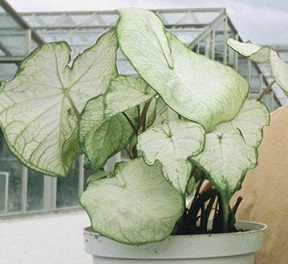
When choosing plants and hardscaping for your moon garden, select pale flowering plant varieties and white objects. Some plants may be picked for their light-colored leaves. Plants whose leaves are variegated, or which have reflective splotches, or which are shiny will reflect any light. Flowering plants with white, pale yellow, or cream-colored blooms will seemingly twinkle in the moonlight. While other plants seem to have a matt sheen of pale white fuzz for even more interest. Below is a short list of plants with leaves which may reflect moonlight:
- fancy leafed Begonia, Begonia heracleifolia
- Caladiums
- Artemisia
- Dusty Miller, Senecio cineraria
- Variegated anything… bromeliads, hibiscus, fish pepper, and Angel Trumpet
Let There Be Light
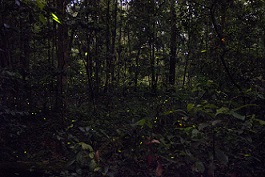
Thankfully, there are still fireflies in certain rural areas of Florida. Attract Fireflies (Lampyridae) to your nighttime garden by providing understory plantings for cover and no artificial lighting. I was very excited to see a firefly in my yard in March, 2019. It was my first in a very long time, and hopefully not my last. Hence, reducing pesticide use may increase your chances of attracting fireflies to your area.
A moonlight garden is also a comfortable place for star gazing or to watch the evening launches from Kennedy Space Center. These night launches literally light up the whole sky. It is breathtaking. Provide white-colored chairs for seating and you will easily be able to find your perch in the moonlight.
Hardscaping
I try to add a few white objects to my landscape. These may be seen on a garden walk or from my windows at night and can include sun-bleached sea shells lining the path. I might not always have time for that evening stroll. It is a comfort to look out at the darkness and have a glimpse of a softly illuminated familiar focal point. And it gives a backdrop to visually identify any movement.
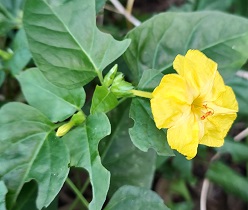
Scent
Add the dimension of scent to your moon garden with fragrant or night-blooming plants. These plants will also attract nighttime pollinators such as large, uniquely shaped Sphinx moths, image below. The plants in the list below possess highly fragrant blooms. There is a white-flowering “4 o’clock” variety but the other colors are just as fragrant and all may be planted from seed.
Night-blooming plants list for scent:
- Angel’s Trumpet, Brugmansia spp.
- 4 O’clocks, Mirabilis jalapa
- Night-blooming jasmine, Cestrum nocturnum
- Sweet almond shrub, Aloysia virgata
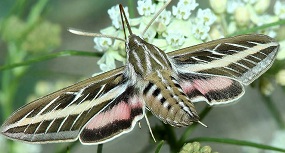
The Night Life
Evening is a time for much activity in nature. Owl spotting is a favorite activity. And having night-blooming plants in the garden will also draw nocturnal pollinators to your landscape. Interestingly, Florida has quite a few species of large, beautifully colorful moths which will be drawn to the fragrance of your moon garden blooms. They are fun to watch flitting from bloom to bloom in the moonlight. Examples include:
- Luna Moth, Actias luna
- IO moth, Automeris io
- Polyphemus moth, Antheraea polyphemus
- Sphynx spp., Sphingidae spp.
- Rosy Maple moth, Dryocampa rubicunda
- Imperialis moth, Eacles imperialis
Can You Hear the Wind Blow?
Auditory sensations in the landscape add a unique layer to the garden. There are many plants which make pleasant sounds when rustled by the breeze- Showy crotalaria and Lunaria annua are two. Additionally, wind chimes provide a soothing organic melody for outdoor relaxation and come in many forms: bamboo, metal, and glass.
7 Florida Native Plants for a Moonlight Garden
If you are looking for white-flowering Florida native plants for your moon garden, here are seven for you to research and track down.
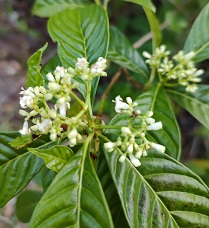
- Button Snakeroot, Eryngium yuccifolium
- Dotted Horsemint, Monarda punctata
- Fringe Tree, Chionanthus virginicus and C. pygmeus
- Simpson Stopper, Myrcianthes fragrans
- Spider lily, Swamp lily, Alligator lily, hyenocallis latifolia
- Wild Coffee, Psychotria nervosa
- Wild Petunia, Ruellia noctiflora
Make a Plan
As with any new planting, it is best to make a site plan. You want your moonlight garden to be happy. Draw up a rough sketch of your site, noting where the structures and large trees are located. For more information on Landscape Design planning, the University of Florida’s Institute of Food and Agricultural Sciences (UF/IFAS) has a publication titled, “Landscape Design: Drawing a Planting Plan”, which will greatly help you begin your nocturnal garden endeavor.
 4
4
